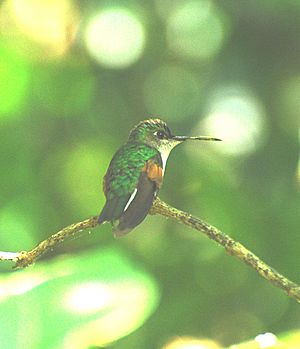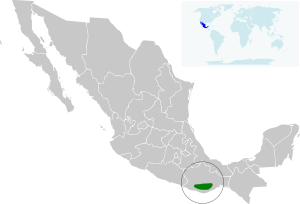Oaxaca hummingbird facts for kids
Quick facts for kids Oaxaca hummingbird |
|
|---|---|
 |
|
| Female | |
| Conservation status | |
| Scientific classification | |
| Genus: |
Eupherusa
|
| Species: |
cyanophrys
|
 |
|
The Oaxaca hummingbird (also known as the blue-capped hummingbird) is a tiny, colorful bird. Its scientific name is Eupherusa cyanophrys. This special hummingbird lives only in the state of Oaxaca, Mexico. Sadly, it is an endangered species, which means there are not many left in the wild.
Contents
What is the Oaxaca Hummingbird?
Hummingbirds are amazing birds known for hovering and drinking nectar. The Oaxaca hummingbird belongs to a group of hummingbirds called "emeralds." Scientists group living things to understand them better. This is called taxonomy. Some scientists once thought the Oaxaca hummingbird was a type of white-tailed hummingbird. Others even thought it was a type of stripe-tailed hummingbird. But now, most scientists agree it is its own unique species.
What Does the Oaxaca Hummingbird Look Like?
This hummingbird is about 10 to 11 cm (3.9 to 4.3 in) long. That's about the length of your hand! It weighs between 4.1 to 5.4 g (0.14 to 0.19 oz), which is lighter than a few paper clips. Both male and female Oaxaca hummingbirds have a straight, black beak.
Male Hummingbirds
Male Oaxaca hummingbirds are very colorful. They have a bright violet-blue forehead and a turquoise crown on their head. Their upper body is a shiny emerald green. When their wings are folded, you can see a patch of reddish-brown feathers. Their two middle tail feathers are green. The other four pairs of tail feathers are whitish. Their belly and chest are a sparkling green, and the feathers under their tail are white.
Female Hummingbirds
Female Oaxaca hummingbirds have green upper parts, similar to the males. They also have the reddish-brown wing patch. Their central tail feathers are green, and the others are white with some dark green. Their underparts (belly and chest) are a pale gray.
Where Does the Oaxaca Hummingbird Live?
The Oaxaca hummingbird lives only in a specific part of southern Oaxaca, Mexico. This area is on the Pacific side of the Sierra Madre del Sur mountains. These mountains are also called the Sierra de Miahuatlán.
Its Home in the Forest
This hummingbird likes to live in humid forests. It can be found at the edges of these forests or deep inside them. It prefers montane (mountain) forests, forests that lose some leaves (semi-deciduous), and pine-oak forests. They live at elevations between 700 and 2,600 m (2,300 and 8,500 ft) above sea level. They are most often seen below 1,800 m (5,900 ft).
How Does the Oaxaca Hummingbird Behave?
Movement
Scientists are still learning about how the Oaxaca hummingbird moves around. It might move to different elevations depending on the season. This means it could fly higher or lower in the mountains at different times of the year.
Feeding Habits
The Oaxaca hummingbird finds its food at all levels of the forest. It searches for nectar from the lowest plants to the tallest trees. While its diet isn't fully known, we know it drinks nectar from flowers like Inga, Lobelia, Malvaviscus, and Psittacanthus. Like other hummingbirds, it probably also eats small arthropods, which are tiny insects and spiders.
Reproduction and Life Cycle
Not much is known about how the Oaxaca hummingbird reproduces. Active nests have been found in May, October, and November. These nests are shaped like cups. They are made of moss and lined with soft plant material. Lichen is often placed on the outside of the nest. The nests are usually built between 1.2 and 5.4 m (4 and 20 ft) above the ground. A female hummingbird usually lays two eggs. We don't know how long it takes for the eggs to hatch or for the young birds to leave the nest.
Vocalization
The song of the Oaxaca hummingbird is described as "high, rapid, and warbling." It sounds similar to the song of the white-tailed hummingbird, but it is "jerkier" and "less hurried." Its calls are not well known, but they also seem similar to the white-tailed hummingbird's "liquid to slightly buzzy, rolled chip" sounds.
Why is the Oaxaca Hummingbird Endangered?
The IUCN (International Union for Conservation of Nature) first listed the Oaxaca hummingbird as "Threatened." But since 1994, it has been listed as "Endangered." This means it is at a very high risk of becoming extinct in the wild.
Small Population and Habitat Loss
This hummingbird has a very small home range. Scientists believe there are only about 600 to 1700 adult birds left. This number is thought to be getting smaller. A big reason for this is that much of the forest where it lives has been destroyed. More forest is being cleared to make space for farms. However, where its habitat is still untouched, the Oaxaca hummingbird is considered fairly common. Protecting its forest home is very important for its survival.
See also
 In Spanish: Colibrí miahuatleco para niños
In Spanish: Colibrí miahuatleco para niños


